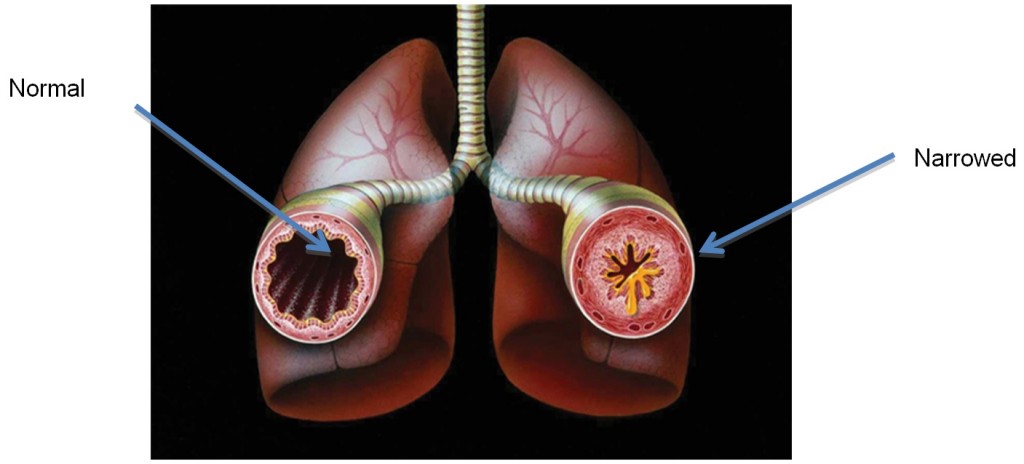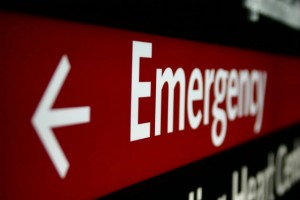Advances in the way asthma treatment have minimized asthma attacks. The latest standard of care and goals for asthma treatment is complete control of symptoms and prevention of asthma attacks. However, asthma attacks still happen. During an asthma attack, the muscles around the bronchial tubes tighten, which narrows the air passages and thus makes it difficult for the person to breathe (Diagram a). Learning to recognize when you or someone else is having an asthma attack and knowing what to do can help save a life.

Diagram The airways normal state (left) & during asthma attack (right)
When YOU are having an asthma attack, the following are recommended:
- Recognize the onset of an asthma attack
An asthma attack can deteriorate into a life-threatening situation that requires immediate medical attention. Know how to identify an asthma attack so that you can begin treatment as soon as possible. Although signs and symptoms of an asthma attack vary depending on the person, the most common symptoms include:[1]- Wheezing or whistling while breathing.Most often the wheezing is heard when a person is breathing out (exhaling) but can sometimes also be heard when they are breathing in (inhaling) [2]
- Coughing
Some sufferers may cough in an attempt to clear the airway and get more oxygen into their lungs. This may be especially aggravated at night [3] - Shortness of breath
People suffering from asthma attacks will complain of being short of breath. They may be breathing in short shallow breaths that appear to be faster than normal [4] - Chest tightness
Attacks are often accompanied by a feeling that chest feels tight or that there is pain on the left or right side [5] - Low peak expiratory flow (PEF) readings
If the person uses a peak flow meter, a small device that measures the maximum speed of expiration in order to monitor a person’s ability to exhale air, and the measurements range from 50% to 79% of your personal best, this is indicative of an asthma flare-up
- Have an action plan in place
- Create an asthma action plan with your doctor
- This plan is basically a step-by-step process of what to do when you face an acute attack. The plan should be written down and include emergency phone numbers as well as those of family and friends who can meet you at the hospital if needed[6]
- Make sure you know how to use your rescue inhalers
- Write this plan down and keep it with you at all times
- Avoid your asthma attack triggers
- In general, note that prevention of symptoms is the best way to manage and treat asthma
- If you know what situations trigger your asthma attacks (such as being around smoky areas, furry animals or extremely hot or cold weather), then try to avoid these when possible [7]
- Get the inhaler prescribed by your physician
Refer to: How to use inhalers - Recognize an asthma emergency
- If your asthma symptoms worsen even after taking your medication, you may need to get emergency medical assistance.
- If you can call emergency services, you should do so.
- However, if your breathing is too labored and you cannot speak clearly, you may need someone to call for you, such as a friend or family member nearby or a passersby.[8]
- Rest while awaiting emergency personnel
- Sit and rest while emergency personnel are coming to your aid. Some asthmatics find sitting in the “tripod” position—leaning forward with their hands on their knees—to be helpful because it can relieve pressure on the diaphragm
- Try to stay calm. Becoming anxious can increase your symptoms
- Ask someone in the vicinity to sit with you to help you stay calm until emergency help arrives
When SOMEONE IS NEAR YOU is having an asthma attack, the following are recommended:
- Stay calm and do not panic
- Reassure them you’re there to help. Do not leave the person alone
- Make sure the person is sitting up so his or her breathing remains as unobstructed as possible
- Eliminate the trigger
- If you know about the person’s history of asthma attacks such as their asthma trigger/s
- Assess the situation to get them away from the trigger/s or remove the trigger/s, if possible. For exampleif you’re near people who are smoking, move away from them

- Emergency plan
- If you do not know the trigger/s, try to determine if there is an emergency plan. These include rescue inhalers (salbutamol, in most cases), bronchodilators, and other anti-inflammatory agents.
- Read the label to determine the appropriate dose.
- Make sure the person follows through with the instructions
- Then ask about his or her action plan for worsening symptoms — whether it’s the use of rescue inhalers, breathing treatments
- Call an ambulance at the first signs of chest tightening
- Know the signs of a severe attack
- Look for any signs that this is a severe attack, one that warrants a trip to the emergency room or at least a call to the physician.
- Signs include:
- Inability to speak more than one or two words per breath
- Feeling distressed and anxious
- Severe chest tightness
- Gasping for breath
- Skin that looks sucked in between the ribs and on the neck,
- A bluish discoloration of the lips
- Pale and sweaty
- Continuing to struggle for breath several minutes after using the rescue inhaler
Finally
- Recognize when your actions aren’t enough
- If the steps in the emergency plan aren’t working
- Or if there is no plan
- Go to an urgent care center / emergency departments of hospitals
- Or CALL AN AMBULANCE IMMEDIATELY. The sooner, the better
REMEMBER
Asthma attacks usually do not just go away on their own
References:
- http://www.aaaai.org/about-the-aaaai/newsroom/asthma-statistics.aspx
- http://acaai.org/asthma/symptoms/asthma-attack
- http://www.nlm.nih.gov/medlineplus/ency/patientinstructions/000062.htm
- http://www.mayoclinic.org/diseases-conditions/asthma- attack/basics/symptoms/con-20034148
- http://acaai.org/asthma/symptoms/asthma-attack
- http://www.mayoclinic.org/diseases-conditions/asthma-attack/basics/symptoms/con-20034148
- http://acaai.org/asthma/about
- http://www.mayoclinic.org/diseases-conditions/asthma-attack/basics/symptoms/con-20034148
- Everyday Health.com
| Last Reviewed | : | 19 May 2016 |
| Translator | : | Dr. Norhaya Mohd Razali |
| Accreditor | : | Dr. Jamalul Azizi Abdul |
 PENDIDIKAN PESAKIT Kementerian Kesihatan Malaysia
PENDIDIKAN PESAKIT Kementerian Kesihatan Malaysia
